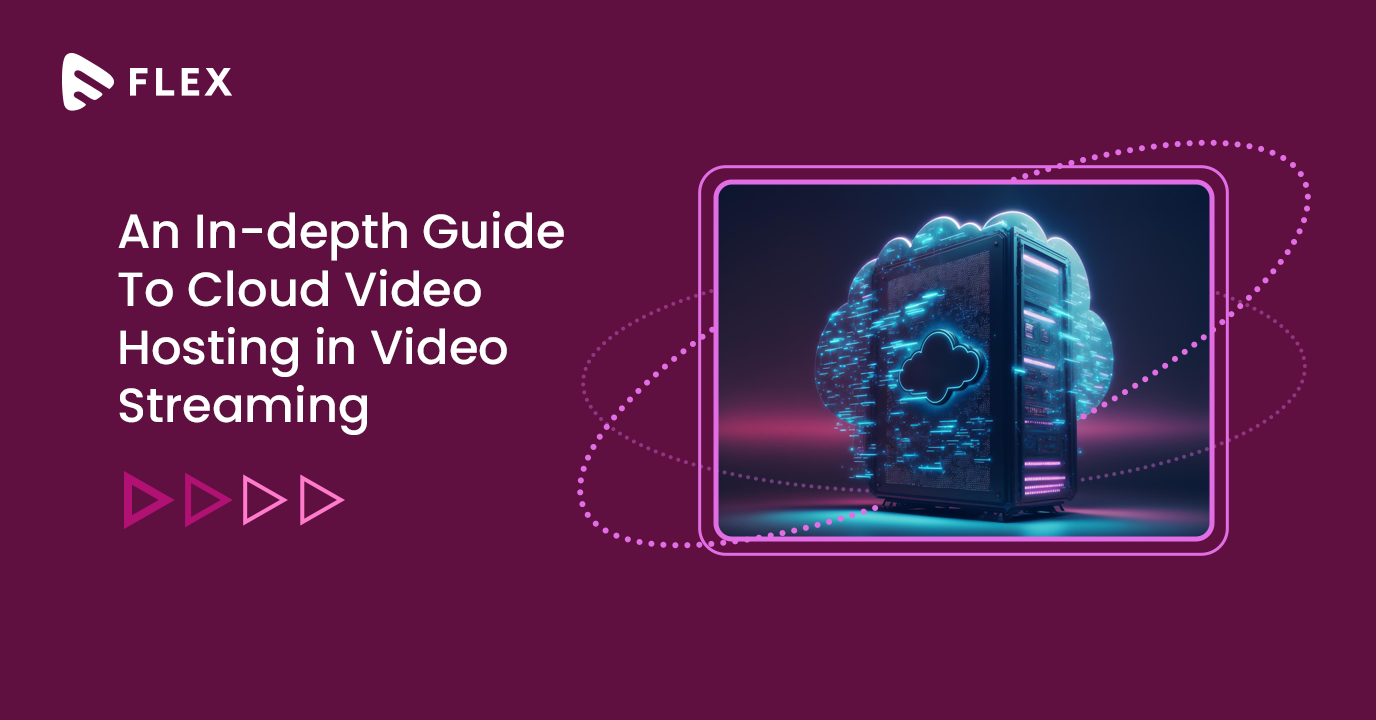Cloud video hosting is pivotal in video streaming. The capacity of cloud infrastructure to efficiently handle and distribute multimedia content is not just a technological advantage; it’s what sustains and propels streaming services to thrive in the competitive industry.
The seamless integration of cloud video hosting not only caters to the insatiable demands of users but also empowers streaming businesses to adapt and innovate rapidly. It facilitates the scalability required to accommodate surges in demand, ensuring a consistently high-quality viewing experience for audiences worldwide.
Beyond its technical capability, cloud video hosting is a strategic imperative for businesses aiming to stay at the forefront of the digital entertainment industry. It enables agile responses to dynamic user preferences, allowing streaming services to maintain relevance and competitiveness. The global accessibility provided by cloud infrastructure further widens the reach of streaming platforms, fostering international expansion and audience engagement. But that’s not it! And in this blog, we will delve deeper into all you need to know about cloud video hosting. So let’s get started!
What Is Cloud Video Hosting?
Cloud video hosting refers to the storage, management, and delivery of video content using cloud-based infrastructure. Unlike traditional hosting methods that rely on dedicated physical servers, cloud video hosting leverages the resources of a distributed network of virtual servers provided by cloud service providers. This approach allows businesses to store and serve video files efficiently while benefiting from the scalability, flexibility, and cost-effectiveness offered by cloud computing.
In a cloud video hosting environment, video files are stored on remote servers, often within multiple data centers globally. These servers are interconnected, enabling seamless content distribution to end-users. Content Delivery Networks (CDNs) are frequently employed in conjunction with cloud video hosting to optimize the delivery speed and reduce latency, ensuring a smooth streaming experience for viewers regardless of their geographical location.
Why Is Cloud Video Hosting Crucial for Video Streaming?
1. Global Accessibility
One of the primary advantages that cloud video hosting brings to video streaming is the ability to ensure global accessibility. Traditional hosting solutions tethered to physical servers often face challenges in providing low-latency access to users across diverse geographical locations.
Cloud video hosting, however, leverages Content Delivery Networks (CDNs) strategically distributed worldwide. This ensures that video content is stored in proximity to end-users, minimizing latency, reducing buffering times, and delivering a seamless streaming experience regardless of the viewer’s location.
The global accessibility afforded by cloud hosting is particularly critical in catering to a geographically dispersed audience. Whether a video streaming service aims to reach viewers in different continents or wants to ensure reliable access in areas with varying network infrastructures, the cloud provides a scalable solution that adapts to diverse audience needs.
2. Scalability and Flexibility
Scalability and flexibility are at the core of cloud video hosting’s significance in the realm of video streaming. As video streaming services experience dynamic shifts in user demand, especially during live events, popular releases, or sudden surges in viewership, the ability to scale resources in real-time becomes paramount.
Cloud hosting allows video streaming platforms to seamlessly scale their infrastructure up or down based on demand. This on-demand scalability ensures that resources are allocated efficiently, preventing issues like server overloads or downtime during peak usage periods. Streaming platforms can optimize their operations and cost-effectively manage resources, paying only for the computing power and storage they use.
Furthermore, the flexibility inherent in cloud video hosting empowers streaming services to experiment with new features, adopt emerging technologies, and swiftly adapt to industry trends. The agility provided by the cloud enables video streaming businesses to stay ahead of the curve, offering innovative and competitive services to their audiences.
3. Enhanced Security Measures
Security is a paramount concern in the digital era, especially when dealing with sensitive video content and user data. Cloud video hosting provides enhanced security measures compared to traditional hosting models. Cloud service providers invest significantly in robust security protocols, ensuring that video content remains protected against unauthorized access, data breaches, and cyber threats.
Key security features include data encryption during transmission and storage, multi-factor authentication, and advanced access controls. Cloud providers also implement redundant storage and backup mechanisms to safeguard against data loss. These security measures contribute to building trust among users, assuring them that their content and personal information are handled with the highest standards of protection.
Moreover, the centralized nature of cloud video hosting allows for efficient monitoring and management of security protocols. Regular updates, patches, and improvements can be implemented seamlessly across the cloud infrastructure, reducing vulnerabilities and strengthening the overall security posture of video streaming service.
4. Cost-Efficiency
One of the primary advantages of cloud video hosting is its inherent cost-efficiency, challenging the traditional model of dedicated physical servers. Cloud hosting operates on a pay-as-you-go model, allowing video streaming platforms to pay only for the computing power, storage, and data transfer they actually use. This shift from capital expenditure to operational expenditure is particularly advantageous for both established players and burgeoning startups in the video streaming space.
Traditional hosting methods often require significant upfront investments in hardware infrastructure. In contrast, cloud video hosting eliminates the need for businesses to purchase, maintain, and upgrade physical servers. This not only reduces initial capital expenditure but also eliminates the ongoing costs associated with server maintenance, cooling systems, and physical security measures.
How Does Cloud Video Hosting Work for Video Streaming?
1. Content Upload to Cloud
The journey begins with the uploading of video content to the cloud, a process that sets the stage for efficient storage, management, and subsequent delivery to end-users.
Storage Infrastructure
- Object Storage: Cloud video hosting typically utilizes object storage services provided by cloud service providers. Objects, in this context, are the individual video files. The use of object storage ensures that content is stored as discrete entities, easily scalable and retrievable.
- Redundancy: To enhance reliability, cloud hosting often employs redundancy measures, storing multiple copies of video files across various servers or data centers. This redundancy minimizes the risk of data loss due to hardware failures.
Content Organization
- Metadata and Indexing: Metadata associated with video files, including titles, descriptions, and user tags, is stored alongside the content. This metadata facilitates efficient organization and retrieval. Indexing mechanisms ensure that content can be quickly located based on various parameters.
2. Encoding and Transcoding
With content securely hosted in the cloud, the process of encoding and transcoding comes into play, ensuring compatibility and optimal quality for diverse viewing scenarios.
Original Encoding
- Resolution and Bitrate: The original video file may be encoded at a specific resolution and bitrate. This encoding represents the base version of the video.
- File Formats: Various file formats, such as MP4 or HLS (HTTP Live Streaming), may be employed for compatibility across different devices and platforms.
Adaptive Bitrate Streaming
- Dynamic Quality Adjustment: Cloud video hosting often implements Adaptive Bitrate Streaming (ABR). ABR dynamically adjusts the quality of the video based on the viewer’s internet connection and device capabilities. This ensures a smooth viewing experience without buffering interruptions.
- Manifest Files: A manifest file, often in the form of an M3U8 file for HLS, contains information about different quality versions of the video. The player dynamically selects the appropriate version based on network conditions.
Transcoding
- Dynamic Format Conversion: Transcoding involves converting the original video file into multiple formats, resolutions, and bitrates. This process caters to a wide range of devices and network conditions.
- Codec Standardization: Transcoding may also involve standardizing video codecs. For instance, converting videos encoded with different codecs (e.g., H.264, VP9) into a common codec ensures consistent playback across various devices.
- Live Encoding: For live streaming events, cloud video hosting incorporates live encoding. This involves capturing, encoding, and transmitting the live feed in real-time. The encoded stream is then distributed through the CDN for seamless delivery to viewers.
3. Storage and Organization
The storage and organization of video content lay the groundwork for a structured and accessible repository, ensuring efficient management and delivery.
Object Storage Architecture
- Entity Representation: In cloud video hosting, video files are treated as discrete entities, often referred to as objects. These objects are stored using object storage services provided by cloud service providers.
- Scalability: Object storage ensures scalability by allowing seamless addition or removal of individual objects. As the volume of video content grows, the cloud infrastructure can effortlessly expand to accommodate the increased load.
Metadata and Indexing
- Metadata Inclusion: Metadata, comprising details like video titles, descriptions, and user tags, is stored alongside the video content. This metadata enriches the organization and discoverability of content.
- Indexing Mechanisms: Robust indexing mechanisms enable quick and efficient retrieval of content. Metadata-driven search and categorization streamline the management of vast content libraries.
Redundancy Measures
- Data Replication: To enhance reliability, cloud video hosting often employs data replication. Multiple copies of video files are stored across diverse servers or data centers. This redundancy minimizes the risk of data loss due to hardware failures or other unforeseen incidents.
- Data Security: Encryption protocols are implemented to ensure data security during storage. Video content may be encrypted, adding an additional layer of protection against unauthorized access.
4. Content Delivery Network (CDN)
The Content Delivery Network (CDN) acts as a global distribution infrastructure, optimizing content delivery speed and reducing latency for users across diverse geographical locations.
Server Distribution
- Global Reach: CDNs consist of strategically placed servers worldwide. This global distribution ensures that users can access video content from servers in proximity, minimizing the distance data needs to travel.
- Edge Servers: Edge servers, positioned at the periphery of the network, cache and deliver content to end-users. This edge caching significantly reduces the round-trip time, enhancing the overall streaming experience.
Caching Mechanisms
- Static and Dynamic Content: CDNs employ caching mechanisms for both static and dynamic content. Static content, such as images or CSS files, is cached at edge servers for quick retrieval. Dynamic content, like streaming videos, may also benefit from caching strategies to optimize delivery.
- Traffic Distribution: Load balancing algorithms distribute incoming traffic across multiple servers. This ensures that no single server is overwhelmed, preventing performance bottlenecks during periods of high demand.
- Dynamic Quality Adjustment: CDNs facilitate Adaptive Bitrate Streaming (ABR), a crucial feature for video streaming. ABR dynamically adjusts the quality of the video based on the viewer’s internet connection and device capabilities, ensuring uninterrupted playback.
5. User Authentication Process
Securing access to video content is paramount, and the user authentication process forms the gateway to controlled and authorized viewing.
- Secure Transmission: During the authentication process, user credentials, such as usernames and passwords, are encrypted to secure them during transmission. Transport Layer Security (TLS) protocols ensure encrypted communication between the user and the server.
- Authentication Tokens: Rather than relying solely on traditional username and password verification, cloud video hosting often implements token-based authentication. Authentication tokens are issued upon successful login and are used to verify subsequent requests, enhancing security.
- Enhanced Security: Multi-Factor Authentication adds an extra layer of security by requiring users to provide multiple forms of identification. This may include a combination of passwords, biometrics, or one-time codes sent to registered devices.
- Fine-grained Control: Access Control Lists define specific permissions for users or user groups. These lists govern who can access certain content, ensuring fine-grained control over viewing privileges.
- Content Protection: In scenarios where stringent content protection is required, Digital Rights Management (DRM) solutions are integrated. DRM encrypts video content, and decryption keys are securely managed to control access rights.
6. Adaptive Bitrate Streaming (ABR)
Adaptive Bitrate Streaming is a cornerstone technology that optimizes video playback quality based on the viewer’s network conditions, device capabilities, and other contextual factors.
- Resolution and Bitrate Variations: ABR involves encoding the same video content in multiple quality versions, each with different resolutions and bitrates. This creates a hierarchy of video files, ranging from lower to higher quality.
- Real-time Adaptation: ABR dynamically adjusts the quality of the video being delivered based on the viewer’s current network conditions. This ensures that the viewer experiences smooth playback without buffering interruptions.
- Manifest Files: A manifest file, often in the form of an M3U8 file for HTTP Live Streaming (HLS), contains information about different quality versions of the video. The player dynamically selects the appropriate version based on the viewer’s available bandwidth and device capabilities.
- Segmentation of Video Content: The video content is divided into small, manageable chunks or segments. Each segment represents a portion of the video and is encoded at different quality levels.
- Adaptive Switching: The player dynamically switches between different quality segments based on the viewer’s network conditions. This adaptive switching occurs seamlessly during playback.
- Buffering for Consistent Playback: ABR utilizes buffer management strategies to ensure consistent playback. The player preloads and buffers segments ahead of the current playback position, providing a buffer that helps mitigate fluctuations in network conditions.
7. Dynamic Resource Allocation
Dynamic Resource Allocation is a pivotal mechanism that enables video streaming platforms to adapt their computing resources in real-time based on the fluctuating demands of viewership.
- Automated Resource Adjustment: Cloud video hosting leverages dynamic resource allocation to automatically scale up or down based on current demand. This scalability ensures optimal performance during periods of high traffic without incurring unnecessary costs during lulls in viewership.
- Traffic Distribution: Load balancing algorithms distribute incoming traffic across multiple servers. This ensures that no single server is overwhelmed, preventing performance bottlenecks during periods of high demand.
- Automated Infrastructure Adjustment: Auto-scaling mechanisms monitor key performance indicators, such as server load and response times. When predefined thresholds are reached, additional resources are automatically provisioned or deallocated.
- Adaptive Transcoding: Dynamic resource allocation extends to the transcoding process. Computing resources allocated to encoding and transcoding tasks are adjusted based on the complexity of the content being streamed.
8. Viewer Request Handling
Viewer Request Handling is the process by which video streaming platforms manage and respond to viewer-initiated requests, ensuring a responsive and interactive user experience.
- Efficient Content Retrieval: Viewer requests trigger the retrieval of specific video content from storage. Cloud video hosting ensures the efficient retrieval of requested content, minimizing latency.
- CDN Optimization: Content Delivery Networks (CDNs) are utilized to optimize the delivery speed. CDNs cache and deliver content from edge servers, reducing the round-trip time for requested content.
- Secure Access Control: Viewer requests involve user authentication and authorization processes. Secure encryption protocols are employed to protect user credentials during transmission, and access control mechanisms, such as tokens and Digital Rights Management (DRM), regulate content access.
- User Analytics: Viewer request handling includes the collection of real-time viewer metrics. This data provides insights into user behavior, preferences, and engagement patterns, enabling content providers to make informed decisions about content offerings and improvements.
- Agile Content Delivery: Viewer requests also trigger updates and changes to the content library. Cloud video hosting allows for instantaneous updates without interrupting ongoing operations. This agility is crucial for implementing security patches, introducing new features, or optimizing content in real-time.

9. Real-Time Analytics Tracking
Real-Time Analytics Tracking is the backbone of data-driven decision-making in video streaming, offering insights into viewer behavior, engagement, and the overall performance of the platform.
- Viewership Patterns: Real-time analytics capture viewership patterns, such as the duration of video sessions, popular content, and the frequency of interactions. This data aids in understanding user preferences and tailoring content offerings to maximize engagement.
- Geographical Distribution: Tracking viewer locations provides insights into the global reach of the streaming service. Content providers can adapt strategies based on regional preferences and optimize content delivery through Content Delivery Networks (CDNs).
- Buffering and Playback Metrics: Real-time analytics track the quality of service metrics, including buffering rates and playback resolutions. This information allows content providers to identify and address issues that may impact the viewer experience, ensuring seamless playback.
- Device Compatibility: Tracking the devices used by viewers provides insights into the diversity of the audience. Content providers can optimize content for various devices, ensuring compatibility and a consistent experience.
- Content Popularity: Analyzing real-time data on content popularity helps in tailoring recommendations and promotions. This proactive approach enhances user satisfaction and content discoverability.
- Ad Performance: For platforms incorporating advertising, real-time analytics track ad performance metrics such as click-through rates and viewer interactions. This data is vital for advertisers and content providers to assess campaign effectiveness.
- Dynamic Content Recommendations: Real-time analytics enable the generation of dynamic content recommendations based on user behavior. By understanding viewer preferences as they unfold, content providers can dynamically adjust recommendations to keep users engaged.
10. Scalable Bandwidth Management
Scalable Bandwidth Management allows video streaming platforms to adapt their infrastructure in real-time to meet the varying demands of viewership.
- Automated Scaling: Scalable Bandwidth Management involves automated resource allocation, allowing the infrastructure to dynamically scale up or down based on current demand. This ensures optimal performance during periods of high traffic without incurring unnecessary costs during lulls in viewership.
- Load Balancing: Load balancing algorithms distribute incoming traffic across multiple servers, preventing any single server from being overwhelmed. This ensures consistent performance even during peak usage.
- CDN Optimization: Scalable Bandwidth Management extends to optimizing Content Delivery Networks (CDNs). By efficiently managing the distribution of content across edge servers, latency is minimized, and the overall content delivery speed is enhanced.
- Elastic Computing: Components of the infrastructure, such as virtual servers and storage, are designed to be elastic. This elasticity allows for on-the-fly adjustments, ensuring that resources are scaled up or down in response to changing conditions.
- Informed Content Strategies: Real-time analytics provide data-driven insights into user behavior and preferences. Content providers can use this information to dynamically adjust content strategies, ensuring that popular content is promoted, and user engagement is maximized.
- Adaptive Resource Allocation: The insights gleaned from real-time analytics inform the scalable bandwidth management system. If a sudden surge in viewership is detected, the infrastructure can adapt by allocating additional resources to maintain optimal performance.
- Identifying Performance Issues: Real-time analytics enable the proactive identification of performance issues, such as buffering rates or playback interruptions. The scalable bandwidth management system can then address these issues by allocating additional resources or optimizing content delivery through CDNs.
- Personalized Viewing Experience: Real-time analytics contribute to the creation of a personalized viewing experience. By understanding individual viewer preferences, content providers can optimize the delivery of recommendations and promotions, enhancing user satisfaction.
Cloud Video Hosting in Video Streaming: The Future Ahead
The video streaming sector has undergone a transformative shift, and the role of cloud video hosting has emerged as a key pillar in shaping the future of the industry. As technology continues to evolve, the convergence of cloud infrastructure, adaptive technologies, and user-centric features propels video streaming into a new era. Here’s a glimpse into the future of cloud video hosting in video streaming.
1. Enhanced Scalability and Flexibility
- Dynamic Resource Scaling: The future of cloud video hosting lies in even more sophisticated resource scaling capabilities. As demand for video content continues to grow, hosting solutions will evolve to provide seamless and instantaneous resource allocation, ensuring optimal performance during peak viewership.
- Microservices Architecture: Cloud video hosting platforms are likely to embrace microservices architecture, allowing for modular scalability. This approach enables independent scaling of specific components, enhancing flexibility and efficiency in resource utilization.
2. AI-Driven Content Optimization
- Personalized Recommendations: Artificial Intelligence (AI) and machine learning algorithms will play a pivotal role in analyzing user behavior. Cloud video hosting platforms will leverage AI to deliver highly personalized content recommendations, creating a more engaging and tailored streaming experience.
- Dynamic Content Tagging: AI-powered content tagging will become more sophisticated, enabling automated analysis of video content. This will facilitate dynamic categorization and tagging, improving the accuracy of search results and content recommendations.
3. Advanced Adaptive Streaming
- AI-Enhanced Adaptive Bitrate Streaming: The future will witness AI-driven enhancements in adaptive bitrate streaming. Machine learning algorithms will predict user network conditions in real-time, allowing for proactive adjustments in video quality to ensure a consistently smooth viewing experience.
- Content-Aware Encoding: Cloud video hosting platforms will implement content-aware encoding techniques, where AI algorithms analyze the complexity of the content and dynamically adjust encoding parameters. This results in optimized video quality and reduced bandwidth requirements.
4. Interactive and Immersive Experiences
- Interactive Features: Cloud video hosting will facilitate more interactive experiences for viewers. Features like interactive overlays, real-time chat, and integrated social media interactions will become standard, creating a more engaging and community-driven environment.
- VR and AR Integration: The future holds the integration of Virtual Reality (VR) and Augmented Reality (AR) technologies into video streaming. Cloud video hosting will support the delivery of immersive content, offering viewers a more interactive and immersive experience.
5. Global Content Delivery Optimization
- Edge Computing for Low Latency: Cloud video hosting will leverage edge computing to reduce latency further. Edge servers, strategically placed closer to end-users, will optimize content delivery, especially for live streaming events, ensuring a broadcast-like experience in real-time.
- Smart CDN Integration: Content Delivery Networks (CDNs) will evolve to become smarter and more adaptive. They will dynamically select optimal servers based on real-time network conditions, ensuring efficient and rapid content delivery on a global scale.
6. Blockchain for Security and Monetization
- Enhanced Content Security: Blockchain technology will be integrated into cloud video hosting to enhance content security. Immutable ledgers and smart contracts will be employed to secure content from piracy and unauthorized distribution.
- Transparent Monetization Models: Blockchain’s transparency and smart contract capabilities will revolutionize monetization in video streaming. Content creators and distributors will have more transparent revenue-sharing models, ensuring fair compensation and reducing intermediaries.
7. Eco-Friendly Streaming Practices
- Green Data Centers: With a growing focus on sustainability, the future of cloud video hosting will witness the adoption of eco-friendly practices. Hosting providers will increasingly invest in green data centers powered by renewable energy sources to reduce the environmental impact of streaming services.
- Optimized Encoding Algorithms: Cloud video hosting platforms will develop more energy-efficient encoding algorithms, optimizing the processing power required for video transcoding. This ensures a sustainable and eco-friendly approach to video streaming.
8. 5G Integration and Edge Computing
- Seamless 5G Integration: The rollout of 5G networks will revolutionize video streaming. Cloud video hosting will seamlessly integrate with 5G infrastructure, enabling higher data speeds, reduced latency, and improved overall streaming quality.
- Decentralized Edge Computing: Edge computing will become more decentralized, with a proliferation of edge nodes. Cloud video hosting platforms will leverage this decentralized approach to bring computing resources closer to end-users, enhancing the efficiency of content delivery.
To Conclude
As the digital landscape transforms, cloud video hosting emerges as the crucial component for the future of video streaming platforms. Its intrinsic features, ranging from scalability and adaptive streaming to advanced analytics and security measures, position it as the indispensable engine driving the evolution of the video hosting ecosystem.
Scalability is at the forefront, allowing platforms to effortlessly scale resources based on demand, ensuring optimal performance during peak usage. This is complemented by the prowess of adaptive bitrate streaming and AI-driven content optimization, promising viewers a personalized, immersive, and consistently high-quality streaming experience.
In this transformative journey, cloud video hosting stands not only as a facilitator but as a catalyst, shaping the very essence of video streaming. As technology continues to advance, the cloud remains the essential canvas where innovation, efficiency, and user-centric experiences converge.
If you want to seamlessly host, embed, share, and manage videos with enterprise-grade security and unmatched scalability, then Muvi Flex is the best option for your video streaming business. Its top-notch features like seamless playlist distribution, easy social sharing, robust player SDK, and geo-restriction, to name a few, help you take your cloud video hosting to the next level. Take a 14-day free trial today to get started.


















Add your comment